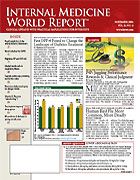Publication
Article
Person-to-Person Transmission of Onychomycosis, Athlete's Foot Confirmed
Author(s):
From Interscience Conference On Antimicrobial Agents & Chemotherapy
SAN FRANCISCO—New, cutting-edge molecular biology techniques have confirmed the long-held but never proven assumption that toenail fungus and tinea pedis can spread from person to person. The findings, which were presented at the Interscience Conference on Antimicrobial Agents and Chemotherapy, have important implications for physicians regarding effective and timely treatment of these infections and preventing transmission within households.
Onychomycosis and tinea pedis (also known as toenail fungus and athlete’s foot, respectively) are most often caused by the dermatophytes Trichophyton rubrum, Trichophyton mentagrophytes, and Epidermophyton floccosum.
This prospective study was conducted at 5 US healthcare centers and enrolled 57 families in which at least 1 member (the index person) had toenail fungus or athlete’s foot. In the 19 families who had ≥2 members infected, the most frequently identified dermatophyte was T rubrum (80.4%), followed by T mentagrophytes (14.3%) and E floccosum (5.3%).
The identity of each species was confirmed by polymerase chain reaction testing; restriction fragment length polymorphism (RFLP) was used to identify DNA molecules for further analysis. By combining these 2 techniques, the identity of each strain could be determined based on its unique DNA band patterns.
Identical dermatophytes were transmitted in 42% (8 of 19) of the families with multiple members infected.
In 7 of these 8 families, T rubrum was detected. Further analysis of DNA band patterns using RFLP revealed that 5 of these 8 families were infected with the same strain of T rubrum. Analysis of the dermatophytes among members of the same household identified the same dermatophyte strain. These findings confirmed that the infection had been transmitted from one family member to another, directly or indirectly.
“The message…is that if you have patients with one of these infections, they need to have treatment. These infections are not going to go away by themselves,” Mahmoud Ghannoum, MD, of the Case Medical Center, Cleveland, Ohio, told IMWR. “We have never had the DNA technology before to be able to confirm how the same strain of fungus is spreading in households. This changes the management of these conditions. Based on this study, a doctor can tell a patient it is better to be treated so that they don’t infect other members of the family.”
Use of patient questionnaires helped identify factors that correlated with the household spread of infection, including a history of onychomycosis or tinea pedis, having athlete’s foot for >10 years, and its occurrence with scaling of the skin on the side of the foot.
“We found that people with a history of toenail fungus and athlete’s foot are 8 times more likely to infect others. So if a patient has it a long time, it is important that they get treated right away,” said Dr Ghannoum.
He said that it is now important to determine why some family members become infected while others do not. “We are planning to extend our studies to examine T rubrum strains….We hope to focus on finding more answers regarding host susceptibility to these infections. It has long been hypothesized that some people have genetic susceptibility to fungal infections, but this has not been proven yet.”






